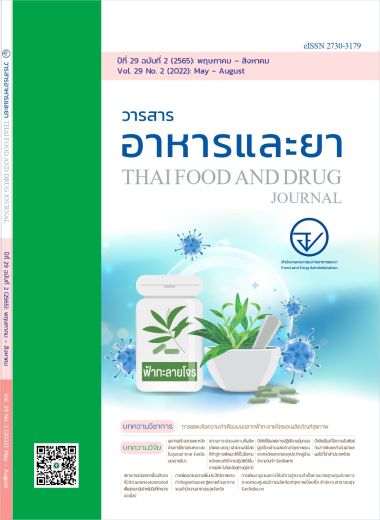สถานการณ์ของสถานที่ผลิต (คัดและบรรจุ) ผักและผลไม้สดที่เข้าสู่การพัฒนาให้เป็นไปตามหลักเกณฑ์วิธีการปฏิบัติที่ดีในการผลิต ในจังหวัดสุราษฎร์ธานี
Main Article Content
บทคัดย่อ
ความสำคัญ: ผักและผลไม้สดเป็นแหล่งของสารอาหารเชิงสุขภาพที่สามารถลดความเสี่ยงต่อโรคไม่ติดต่อเรื้อรังต่าง ๆ ได้ แต่ปัญหาสารเคมีกำจัดศัตรูพืชตกค้างเกินค่ามาตรฐาน ส่งผลต่อความไม่มั่นใจของประชาชน กระทรวงสาธารณสุข ได้ออกประกาศกระทรวงสาธารณสุข เลขที่ 386 พ.ศ. 2560 เรื่อง กำหนดวิธีการผลิต เครื่องมือ เครื่องใช้ในการผลิตและการเก็บรักษาผักหรือผลไม้สดบางชนิด และการแสดงฉลาก ให้เป็นมาตรฐานบังคับทั่วประเทศ โดยในจังหวัดสุราษฎร์ธานีมีสถานที่ผลิต (คัดและบรรจุ) ผักและผลไม้สด จำนวน 20 แห่งที่ต้องพัฒนาให้เป็นไปตามประกาศฯ
วัตถุประสงค์: เพื่อศึกษาสถานการณ์ของสถานที่ผลิต (คัดและบรรจุ) ผักและผลไม้สดบางชนิดที่เข้าสู่การพัฒนาให้เป็นไปตามหลักเกณฑ์วิธีการปฏิบัติที่ดีในการผลิต รวมถึงค้นหาปัญหาและข้อเสนอแนะจากผู้มีส่วนได้ส่วนเสียในการพัฒนาสถานที่ผลิตในจังหวัดสุราษฎร์ธานี
วิธีการวิจัย: เป็นการวิจัยเชิงสำรวจในจังหวัดสุราษฎร์ธานี ใช้ประชากรทั้งหมดที่เป็นผู้ประกอบการสถานที่ผลิต (คัดและบรรจุ) ผักและผลไม้สด จำนวน 20 แห่ง โดยตรวจประเมินสถานที่พร้อมให้คำแนะนำเพื่อพัฒนา 2 ครั้งในช่วงเดือนมีนาคม – ธันวาคม 2561 และมกราคม – สิงหาคม 2562 และสัมภาษณ์เชิงลึกผู้ประกอบการและพนักงานเจ้าหน้าที่จำนวน 30 ตัวอย่าง เพื่อค้นหาปัญหาและข้อเสนอแนะในประเด็นเกี่ยวกับการบังคับใช้ประกาศกระทรวงสาธารณสุข เลขที่ 386
ผลการศึกษา: การตรวจประเมินสถานที่ผลิต (คัดและบรรจุ) ผักและผลไม้สดในจังหวัดสุราษฎร์ธานี พบว่า ครั้งที่ 1 ผู้ประกอบการสามารถปฏิบัติตามหลักเกณฑ์ GMP 3 แห่ง (ร้อยละ 15) แต่หลังจากประเมินและให้ความรู้ทำให้ครั้งที่ 2 เพิ่มเป็น 17 แห่ง (ร้อยละ 85) คะแนนรวมของการตรวจประเมินทุกแห่งเพิ่มขึ้นอย่างมีนัยสำคัญทางสถิติ (p<0.001) พบข้อบกพร่องรุนแรงที่ทำให้ไม่ผ่านเกณฑ์คือ การควบคุมการใช้สารเคมีในแหล่งเพาะปลูกไม่ครบทุกแหล่ง 3 แห่ง (ร้อยละ 15) มีทะเบียนเกษตรกรไม่ครบทุกแหล่งวัตถุดิบ และการบ่งชี้รุ่นผลิตในผลิตภัณฑ์ไม่ถูกต้อง มีจำนวนเท่ากัน 2 แห่ง (ร้อยละ 10) และจากการสัมภาษณ์เชิงลึกกลุ่มตัวอย่างมีเห็นว่าประกาศฉบับนี้ควรบังคับใช้กับผักและผลไม้สดทุกชนิดเพื่อความปลอดภัยในการบริโภค และภาครัฐและภาคเอกชนควรร่วมมือกันสนับสนุนผู้ประกอบการในการพัฒนาสถานที่ผลิต
สรุป: สถานที่ผลิต (คัดและบรรจุ) ผักและผลไม้สดในจังหวัดสุราษฎร์ธานีสามารถพัฒนาจนผ่าน GMP ได้อย่างมีนัยสำคัญทางสถิติ ปัจจัยความสำเร็จคือการตรวจประเมินและให้คำแนะนำความรู้ แต่สถานที่ที่ไม่สามารถพัฒนาได้ มีปัญหาสำคัญคือการควบคุมการใช้สารเคมีในแหล่งเพาะปลูก ดังนั้น หน่วยงานภาครัฐและเอกจนควรบูรณาการความร่วมมือกันเพื่อควบคุมแหล่งเพาะปลูกให้ปลอดภัยจากการใช้สารเคมีตั้งแต่ต้นทาง รวมทั้งพัฒนาชุดทดสอบตรวจสารเคมีให้ง่ายต่อการใช้งาน และประชาสัมพันธ์ให้ประชาชนทราบวิธีเลือกผักและผลไม้สดมาบริโภค เพื่อให้เกิดความปลอดภัยตลอดห่วงโซ่การบริโภคผลิตผักและผลไม้สด
Article Details

อนุญาตภายใต้เงื่อนไข Creative Commons Attribution 4.0 International License.
เอกสารอ้างอิง
ชนิพรรณ บุตรยี่. บริโภคผักผลไม้อย่างน้อยวันละ 400 กรัม เพื่อสุขภาพ: หลักฐานเชิงประจักษ์. วารสารโภชนาการ 2563;55(1):53-65.
สถาบันวิจัยระบบสาธารณสุข. 4 สารพิษตกค้าง อันตรายที่ต้องระวัง[อินเทอร์เน็ต].2558 [เข้าถึงเมื่อ 20 เม.ย. 2564]. เข้าถึงได้จาก https://www.hsri.or.th/people/media/care/detail/6037
ชวนพิศ อรุณรังสิกุล. โครงการมาตรฐานความปลอดภัยสินค้าตลอดห่วงโซ่การผลิต เพื่อเป็นข้อมูลสนับสนุนการขับเคลื่อนยุทธศาสตร์ความปลอดภัยอาหาร ผัก รายงานวิจัยฉบับสมบูรณ์.กรุงเทพฯ: สำนักงานกองทุนสนับสนุนการวิจัย; 2556.
กระทรวงเกษตรและสหกรณ์. ประกาศกระทรวงเกษตรและสหกรณ์ เรื่อง กำหนดมาตรฐานสินค้าเกษตร : การปฏิบัติที่ดีสำหรับโรงคัดและบรรจุผักและผลไม้สดตามพระราชบัญญัติมาตรฐานสินค้าเกษตร พ.ศ. 2551. ราชกิจจานุเบกษา เล่มที่ 137, ตอนพิเศษ 197 ง (ลงวันที่ 27 สิงหาคม 2563).
กระทรวงสาธารณสุข. ประกาศกระทรวงสาธารณสุข เรื่อง ประกาศกระทรวงสาธารณสุข เลขที่ 386 พ.ศ. 2560 เรื่อง กำหนดวิธีการผลิต เครื่องมือ เครื่องใช้ในการผลิตและการเก็บรักษาผักหรือผลไม้สดบางชนิด และการแสดงฉลาก. ราชกิจจานุเบกษา เล่มที่ 134, ตอนพิเศษ 211 ง (ลงวันที่ 20 สิงหาคม 2560).
พูลลาภ ฉันทวิจิตรวงศ์. สถานการณ์ปัญหาการปนเปื้อนของสารพิษตกค้างทางการเกษตร. ใน: ประชุมชี้แจงประกาศสำนักงานคณะกรรมการอาหารและยา เรื่อง คำชี้แจงมาตรการเฝ้าระวังผักและผลไม้ที่อาจมีสารพิษตกค้างทางการเกษตร; 28 มกราคม 2563; ณ ห้องจูปิเตอร์ โรงแรมมิราเคิล แกรนด์ คอนเวนชั่น. กรุงเทพ; 2563.
พวงเพ็ชร์ นิธยานนท์. การศึกษาระบบบริหารจัดการโรงคัดบรรจุผักและผลไม้สดเพื่อพัฒนาให้เป็นไปตามเกณฑ์วิธีการที่ดีในการผลิต. วารสารปัญญาภิวัฒน์ 2561; 10(ฉบับพิเศษ):124-134.
สำนักงานคณะกรรมการอาหารและยา กระทรวงสาธารณสุข. คู่มือการตรวจสถานที่ผลิต (คัดและบรรจุ) ผักและผลไม้สดตามหลักเกณฑ์วิธีการผลิต เครื่องมือ เครื่องใช้ในการผลิตและการเก็บรักษาผักหรือผลไม้สดบางชนิด. นนทบุรี: 2560.


